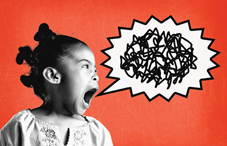
Psychologists are using research-backed behavioral interventions that effectively treat children with ADHD.
By Rebecca A. Clay
February 2013, Vol 44, No. 2
Print version: page 44
Because of his attention-deficit/hyperactivity disorder (ADHD), the 10-year-old boy rarely even tried to answer the questions on the math and language arts worksheets his fourth-grade teacher asked students to complete during class. Not only that, he often bothered the students who did.
Then the teacher made an important change to the boy's worksheets: She wrote the correct answers on them with invisible markers so that the boy could reveal the correct answer by coloring over the space as soon as he finished a question. The teacher also randomly inserted stars he could uncover by coloring and told him he would earn a reward for collecting four stars. The strategy paid off: The boy was soon answering every question and getting 84 percent of them correct.
Giving immediate feedback is just one of many simple and effective behavioral approaches to improving children's attention, says psychologist Nancy A. Neef, PhD, who described the invisible marker experiment in a chapter on treating ADHD she co-authored in the 2012 " APA Handbook of Behavior Analysis ." With ADHD affecting an estimated 7 percent of American children ages 3 to 17, psychologists are developing behavioral interventions that parents, teachers and others can use to help kids focus and control their impulses. Others are conducting research that demonstrates that more exercise and longer sleep can help.
That's good news for kids, says Neef, who believes that parents, teachers and pediatricians are sometimes too quick to jump to prescribing medication for ADHD.
"Particularly in the case of stimulant medications, which are the most common treatment for ADHD, we don't know an awful lot about the long-term side effects," says Neef, a professor of special education at The Ohio State University.
And medication doesn't address problems related to children's academic performance and relationships with family members, peers and others. "Even though medication can be effective and very helpful, it's not a panacea," Neef says.
Behavioral interventionsSurprisingly, nonpharmacological approaches are also controversial, especially among the medical community.
"If you read the professional guidelines for psychiatrists or sometimes pediatricians, the treatment that is emphasized for kids with ADHD is a pharmacological one," says Gregory A. Fabiano, PhD, an associate professor of counseling, school and educational psychology at the State University of New York at Buffalo.
That bias toward pharmacological approaches has its roots in a large study by the Multimodal Treatment of ADHD (MTA) Cooperative Group, published in 1999 in the Archives of Psychiatry . The study, which compared medication, intensive behavioral treatment, a combined approach and standard community care, concluded that medication worked best. "The field took that result and ran with it," says Fabiano.
But since then, a number of papers have followed up on the original study participants. "They have found that some of those conclusions may have been if you just looked at the immediate post-treatment results," he says. "If you look at how well they work over time, any differences seem to subside."
He points as an example to a 2007 article in the Journal of the Academy of Child and Adolescent Psychiatry . A three-year follow-up of the MTA study, the paper found that while medication and the combined approach had a significant advantage at the 14- and 24-month follow-up, that advantage faded over time. At the 36-month point, the treatment groups didn't differ significantly on any measure.
Fabiano's own work, a meta-analysis published in 2009 in Clinical Psychology Review , found that behavioral treatments for ADHD are highly effective. Fabiano and his coauthors examined 174 studies of behavioral treatments in 114 papers. These treatments fell into three broad categories:
- Parent programs. These interventions focus on teaching parents strategies for helping their children succeed. One such approach is to catch children being good. "If you think about the typical child with ADHD, they're always noticed when they're messing up," says Fabiano. "One of the things we try to teach adults to do is to also notice them when they're doing the right thing and then label and comment on it so they're getting attention for good behavior."
- Teacher programs. Like the invisible marker example, these interventions offer teachers behavioral strategies for the classroom. They include giving straightforward, one-step-at-a-time instructions to children and announcing the consequences of not paying attention ahead of time. Another effective approach is contingency management. With this strategy, children receive daily report cards that outline how well they have met such goals as speaking in turn or bringing their homework back to class. When they meet those goals, they receive awards.
- Therapeutic recreational programs. In these programs, children with ADHD interact with each other at summer camps and similar venues. The programs offer crafts, sports and traditional camp activities in addition to behavioral interventions. In contrast to the usual ADHD treatment, these interventions last all day long for several weeks at a time. Programming typically includes brief social skills training sessions plus coached group play incorporating contingency management strategies. In addition to learning social skills, participants also learn sports and team membership skills.
"A lot of this isn't rocket science," Fabiano admits. "The hard part is keeping these interventions going."
But the key is early intervention, says psychologist George J. DuPaul, PhD, co-author of the 2011 book " Young Children with ADHD: Early Identification and Intervention ." Even the American Academy of Pediatricians' 2011 treatment guidelines say that behavioral strategies should be the first line of treatment for young children with ADHD.
"These are students who enter kindergarten and first grade already behind academically and behaviorally and never quite catch up," says DuPaul, who chairs the department of education and human services at Lehigh University's College of Education. "Early intervention in the preschool years offers the opportunity to get a head start on trying to bridge the gap between students with attention problems and their peers."
As a result, says DuPaul, behavioral interventions should begin even before children start school. Parents can introduce preschoolers to early literacy and numeracy activities to give them the extra head start they need, he suggests. Psychologists can also teach families how to identify the real reason children with ADHD engage in problematic behavior and what to do about it. A child who ignores directions when asked to put away his toys and come to dinner, for example, may be trying to communicate that he wants to keep playing. Parents can learn to redirect such behavior by teaching the child to communicate his desires verbally, warning him about upcoming transitions and invoking consequences when he fails to follow directions — techniques that can also benefit children who don't have ADHD.
Psychologists can also teach others in children's lives how to use such techniques, DuPaul says. A preschool teacher reading a story to preschoolers, for instance, can praise children who are not talking to neighbors. Once the chattering child notices that praise and stops talking, says DuPaul, the teacher can "pivot" to praising that child.
Lifestyle changesHealthy living may also help children with ADHD — as well as everyone else — maintain their focus. And unlike medication, it's free.
Exercise is one powerful intervention, says Matthew B. Pontifex, PhD, an assistant professor of kinesiology at Michigan State University. His research suggests that even a few minutes of physical activity a day can help children with ADHD ignore distractions, stay focused on tasks and boost their academic performance.
In a study published last year in the Journal of Pediatrics , Pontifex and his co-authors had 40 elementary school-age children — half with ADHD — spend 20 minutes striding on a treadmill or quietly reading. Whether they had ADHD or not, the children performed better on math and reading comprehension tests after exercising. The exercisers with ADHD were better able to slow down and avoid repeat mistakes while playing a computer game.
For psychologists, says Pontifex, the implications are clear. "At the very least, exercise might be a frontline thing to consider in treatment," he says.
There are policy implications as well, he adds. Schools are under pressure to cut recess and physical education to make way for subjects that will help children perform better on standardized tests, he explains. "This research provides some empirical basis to suggest there would be a potential benefit for having those physical exercise opportunities during the school day," he says.
Sleep may be another no-cost intervention, says psychologist Reut Gruber, PhD, an assistant professor of psychiatry and director of the Attention, Behavior, and Sleep Lab at McGill University. Her research with typically developing children without ADHD suggests that even just a half-hour of extra sleep can keep kids from being restless at school and improve their behavior. Conversely, cutting back on sleep can result in tears, tantrums and frustration.
In a paper published in 2012 in Pediatrics , she and her colleagues studied sleep's impact on 34 children ages 7 to 11. The parents of half the kids were told to give their children an extra hour of sleep; the others were told to cut sleep time by an hour. While wristwatch-like devices called actigraphs that the children wore revealed that the extra-sleep group ended up sleeping only an extra half-hour on average, that small increase was enough to produce noticeable results. According to teacher ratings, behavior improved among the kids who got more sleep and deteriorated among those who got less.
Past studies have shown that children with ADHD tend to be hypoaroused, says Gruber. Unlike adults, who typically slow down when they're tired, children with or without ADHD often manifest fatigue by getting hyperactive.
"From the outside, they make look very energetic, but really it's the opposite," says Gruber. "It has been proposed that one reason for hyperactivity is that it helps children stay awake."
Rebecca A. Clay is a writer in Washington, D.C.
This article has been reproduced from http://www.apa.org/monitor/201...
www.apa.org/monitor/2013/02/easing-adhd.aspx






